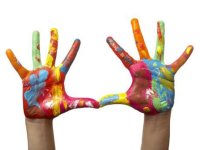Creativity is the Secret Sauce in STEM
Humans have a few basic needs: air, food, water, clothing, shelter, belonging, intimacy and Wi-Fi. (OK, the last one is not really on the list.) Regardless of my attempt to be funny, what is no laughing matter is that we have primary needs. What might surprise you is that another primary need is the need to be creative. We are creative creatures and have been since we first existed, as evidenced by the first cave paintings formed over 40,000 years ago. But somehow in this modern day, we've forgotten that being creative is part of the human experience.
There is plenty of talk in the news about making our children more creative to prepare for the jobs for the 21st century. The word "creativity" is used a lot, but no one is taking the time to define it. Plato used to think frequently about creativity and would describe it as being a channel for a muse. OK, where can you get a muse these days? eBay? As you can see, this intangible and hard-to-describe resource makes it very hard to identify, never mind nurture and teach. However, we know creativity when we see it. And, despite all this confusion, we also know that everyone is creative (to varying degrees).
Creativity is the secret sauce to science, technology, engineering and math (STEM). It is a STEM virtue. While most scientists and engineers might be reluctant to admit that, and to accept the concept of STEAM (where A is for Art), I’ve witnessed that the best of the best are the most creative.
So how do we make our children more creative?
Researchers have found that play is important for productive thought. Playing with ideas also increases learning. We must encourage playing with concepts to nurture creativity in students.1 Can you show the material you are discussing in far-out ways? Can it be compared to a sport, an event or a celebrity? Try it. Playing with concepts provides multiple entry points and multiple ways of engagement.
Creativity Breaks the Ice to Enable Learning
Recently, I taught a chemistry class to liberal arts majors. It could have been a setup for an epic fail. These students had avoided science all through their college years until now, and they needed this course to graduate. So I had to find ways to break the ice and make these chemistry concepts more palatable and fun. My approach was to merge two things that we never really link -- compare how humans and atoms behave similarly in certain situations. Everyone believes he or she is a human-relationship expert, so why not compare the known to the unknown? That is, how humans act when bonding with each other can be compared to how atoms bond too. This anthropomorphized or metaphorical approach bridges the scary with the not-so-scary. It also increases dialog and understanding, and serves as an idiom (where one can use less words to describe something). Metaphors are a beautiful thing.
Creativity is really the art of metaphor.
Metaphors create a linkage between two dissimilar ideas and are useful in the sciences because they allow information to be attained by connecting the unknown with the known.2 And this is the key element to scientific creativity. Metaphors are important because they create a means of seeking answers, and sometimes they free us from the common thinking and enable scientific breakthroughs.
Most scientists won't admit it, but metaphors are part of their toolkit. They are peppered into scientific language, unsuspectingly. Scientists will say light waves, electric current and magnetic fields.3 But they do not literally mean an ocean of light, a stream of electricity or a pasture of magnets. These phrases make connections between that thing we know and that thing we are trying to explore. Metaphors are thought-mappings that help understanding.
Newton figured out that celestial bodies and the earth were linked by gravity. An apple falling to the earth was a metaphor for the linkages between the earth and the moon. Kepler linked the workings of a clock to the motion of the planets. Bohr visualized the atom as a mini-solar system. Metaphors can help us take a cerebral leap. We need parallels -- a cell is a city, atoms are billiard balls, and DNA are spiral staircases -- so that we can play with these concepts to uncover answers and enable learning.
Metaphors are wonderful tools for teaching and learning. As I say in Save Our Science, the skills of the 21st century need us to create scholars that can link the unlinkable. These scholars must be willing to try many combinations before finding the right answer. They must be comfortable with concepts that they can play with in new ways. We want smart-thinking creative people. This is the formula for a better tomorrow.
Notes
1H. Poincare, in The Creative Process: A Symposium, B. Ghiselin, Ed. (University of California Press, Berkeley, CA, 1954).
2A. I. Miller, in Metaphor and Analogy in the Sciences, F. Hallyn, Ed. (Kluwer Academic Publishing, London, 2000), pp. 147-164.
3G. Simon, in Metaphor and Analogy in the Sciences, F. Hallyn, Ed. (Kluwer Academic Publishers, London, 2000), pp. 71-82.
